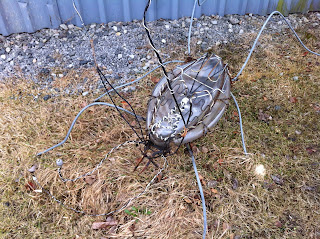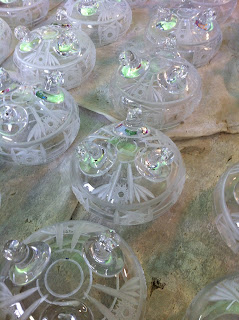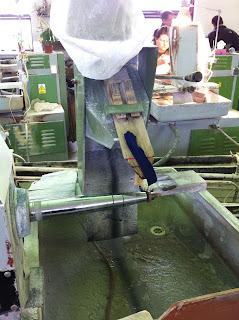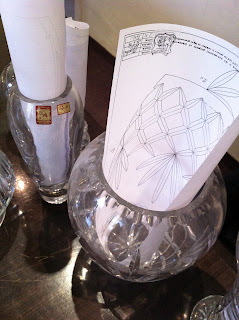While in all three countries on this past trip, one major
observation I made was the environmental consciousness of the people. This environmental consciousness ranged from
very simple habits to initiatives through infrastructures.
Upon landing in Munich, the first two big environmentally
friendly things I noticed were recycling receptacles in public areas and the
large public transportation system. In
airports, subway stations, and in the streets, one could find not only a trash
and recycling receptacles, but recycling receptacles for paper, glass, plastic,
and tin. The public transportation was
immediately apparent once setting forth from the airport. Extensive S-Bahn (suburban trains), U-Bahn
(subways), tram, and bus systems were all in place within Munich. I would soon learn that most major European
cities in that region also would have such systems. Linz and Prague later both proved to me
further that such systems are a part of, and indeed integral to, daily living
in those cities. One of our tour guides
would later tell us that a flooded subway line in Prague nearly shut the city
down for six months. The amount of auto
emissions that must be eliminated by such extensive train use is likely
astronomical. Rarely during the day
would we ride any of these networks where the train was not filled with a
decent amount of people.
In addition to the rail networks and availability of public
transportation, it has continued to impress me just how many pedestrians and
bike riders are in the cities. As we
rode through stations while on the train, we noticed huge lots full of
bikes. These were all of the people who
had ridden to the train station to catch passage to another town or suburb. In America, I would have expected to see full
parking lots of cars. I know when I was
younger I would drive my car three blocks just to get to high school. In central Europe, this would have been
non-sense. Even better than watching
just how many bicyclists there were was seeing how well the city’s
infrastructure supported such riders.
Not only were bike lots readily available, but so were bike paths on
roads. These were separate from
pedestrian walk ways, and if you were not careful, you would quickly get run
over by a bike. At intersections, a
bicycle lamp would indicate when cyclists could cross. In downtown Cincinnati, I would have been
very nervous to ride a bike. In downtown
Munich, I would have felt perfectly fine.
There was almost a complete absence of cars in many cases. Pedestrian zones were everywhere in the
downtown area. While sitting for lunch
one day, one of the guys noted that it was extremely quiet downtown. I immediately thought, “That’s because there
are no major freeways running right through the inner city like most do in the
States.” Because of that fact, the air
quality downtown was also greatly improved.
Environmental consciousness extended to rural environments
as well. As we would pass through the
country side, we could see many houses with solar panels mounted on as many
surfaces as was convenient. Even from
the airplane window as we landed, I could see the shimmer of panels on many
houses. Windmill generators could also
be seen in the distance from many areas.
The use of these alternative energy forms showed great initiative on
being environmentally conscious.
I notice many smaller things in Europe as well. There were many light sensors that turned on
lights in public facilities only when there was motion in a room. Toilets had two flush options… big and
small. The small one could be used if
not as much water was necessary. Many
bottles contained labels for what was known as Pfand. This was basically a
return price for the bottle. Grocers
would often have giant recycling machines right in the store. After purchasing a bottle of water and
drinking it, one could simply return it to the store for as much as 0.30 Euros
back. The machines in the stores would
actually then crush the bottles and store them to be shipped to a recycling
plant. Bathrooms rarely had paper
towels; most had hand dryers. Restaurants
primarily gave out linen napkins. Most
paper trash in restaurants came from American chains which were in the region. In grocery stores, one would use reusable
bags over plastic bags.
My final major observation with the environmental consciousness
came through the types of vehicles that were used. Almost all consumer vehicles in the regions
we visited were small passenger cars.
Very few trucks, SUVs, or vans were to be found. If larger vehicles were needed, many
hatchbacks seem to be the popular alternative.
Of the small cars we noticed, many were also utilizing hybrid
technologies. Even some buses and taxis
used hybrid technology.
Reflecting on these conservation initiatives, one wonders
why they are so much more resourceful than we are in America. My initial thoughts were that such consciousness
was borne more out of physical circumstances.
In Europe, less land means fewer resources. This, in turn, means using the resources more
conservatively. They don’t have giant
open spaces for landfills like we do in the States. After doing some research, I found that this
actually has a lot to do with Europe’s keener watch on their carbon footprint.
Not only are cars smaller in Europe, but so are houses. With less land available, real estate becomes
much pricier. With smaller homes and
apartments, less energy must be consumed to sustain inhabitants. Not only this, but the way those houses are
constructed lends well to the environment.
Many apartments that I saw had balconies. On these balconies, and if outdoor space was available,
laundry could often be seen drying. Upon
further research, I found that most households do not own their own washer and
dryer. Most do not have central air
units. Why? The biggest reason is likely that no space
exists for them. With many buildings in
Europe, they were constructed before such amenities were available. In addition, most buildings in Europe are
constructed attached to one another.
This helps conserve heat and energy as well. This concept of pre-dating amenities applies
to cities too. Most cities in Europe
grew long before the car industry even existed.
Because of this, streets are smaller, and cars must also be smaller.
In 2008, the CO2 emission in metric tons per capita in the
USA was 17.5. This is compared to 9.6,
8.1, and 11.3 in Germany, Austria, and the Czech Republic respectively. We produce more than TWICE the emissions as
Austria! This is an amazing figure. I know it makes me think twice about how
often I waste energy as a US citizen.
 |
| CO2 Emissions per capita (courtesy of Wikipedia) |
In the end, it is interesting to see how circumstances in a
country can affect the effect that country has on the planet. Perhaps it is not that Europeans are
necessarily more environmentally conscious (I would still say they are), but
that they were born into a culture where those more environmentally friendly
systems arose naturally. Smaller houses
and cars came about because of the way cities developed. Fewer landfills arose because of the
commodity of land and the proximity of cities.
Ultimately, it is an eye opener. As an American, it is probably good to be
exposed to a culture that will make you feel guilty if you throw a plastic
bottle in the trash can. I know I felt awkward
the first time I left a grocer with a plastic bag. When everyone around you carries a reusable
one, it makes more sense to switch systems.
I think eventually such things will catch on in America, but as with most
major changes, these will come over time and with patience.
In the mean time, one might ask what implications this
European characteristic has on profession and social interactions between
European countries and in their international partners. One clear implication is both a sense of
rivalry and responsibility in instituting good corporate responsibility
initiatives. This was very clear when we
visited Voestalpine in Linz, Austria.
They mention not once or twice… but several times that they were
probably the cleanest steel manufacturing plant (in terms of air quality) in
Europe. They were very proud of their
ability to reduce damaging emission by over 90% in the past decade. This in turn pushes other industries in
Europe to meet those standards. It was
clear from a multitude of conversations that the government has also been more
thorough in regulating such corporate responsibility. On a social level, it is clear that Europeans
push each other towards more responsible environmental actions through
habit. Be it recycling or voting for
certain political parties, these habits and trends permeate through each
country on the continent.
The implications of these internal interactions have been
seen globally as well. In my college experience,
it has not been uncommon to hear things like, “Europe is much better at
recycling than we are.” As a young
American population, we are very aware that across the Atlantic, their green initiatives
are becoming successful. I think this
really pushes many Americans to meet a similar expectation here in our own
country. That is the social end of it. On a corporate level, the same thing is
happening. Because businesses have
become much better at learning from each other in the past couple of decades,
they are also more and more aware of the level of corporate responsibility that
is typical and beneficial for a company.
In America, many of our own businesses are adopting practices that
mirror those being used in Europe for environmental protection. In this regard, the global community becomes
a great tool in focusing all nations towards more positive aims.

















































































































